Mar 25, 2022
Artificial Intelligence and Neuroscience: A Symbiotic Relationship
Posted by Jose Ruben Rodriguez Fuentes in categories: neuroscience, robotics/AI
AI and neuroscience have too many similarities. While Artificial neural networks mimic the human brain, the human behaviour holds generous data for Artificial intelligence to train itself into human mind.


















